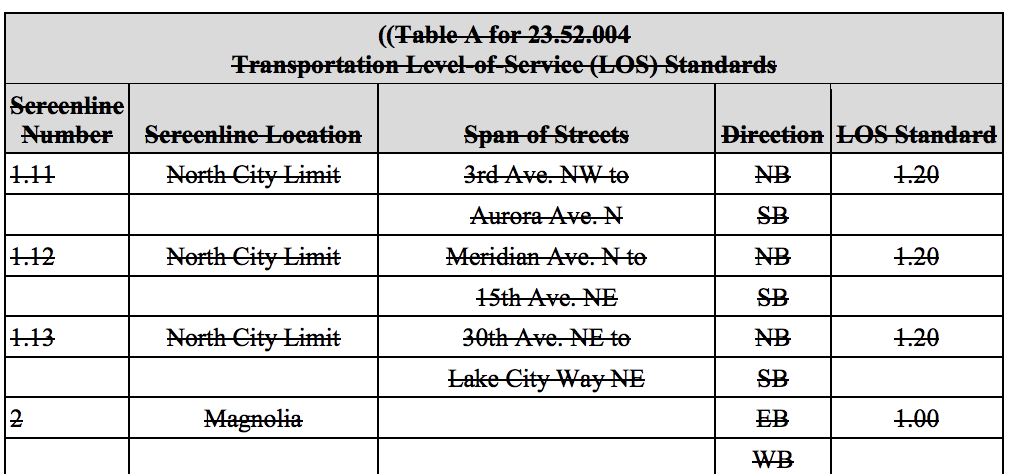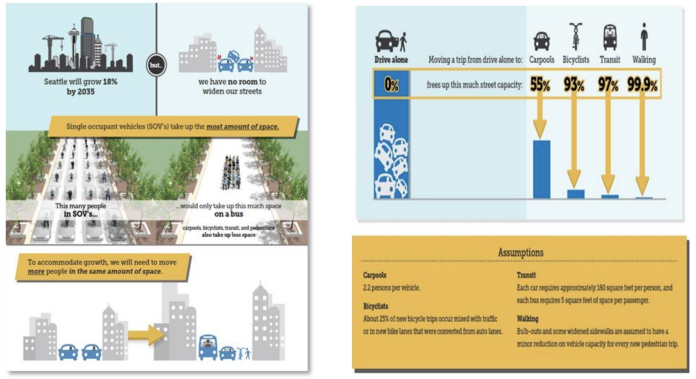On Wednesday, the Seattle City Council’s held the last Planning, Land Use, and Zoning Committee meeting of the year. Three items were on the agenda, with changes to regulatory requirements for transportation level-of-service standards being the most substantial issue before councilmembers and receiving a vote out of committee. Councilmembers also heard briefings on new design guidelines for the University District and Uptown. Both sets of proposed design guidelines follow on the heels of rezoning frameworks that the city council approved in 2017.
Reforming Implementation of Transportation Level-of-Service Standards
During the meeting, staff from the Seattle Department of Construction and Inspections (SDCI) and Office of Planning and Community Development (OPCD) briefed councilmembers on a suite of proposed changes to the city’s regulatory requirements for transportation level-of-service (LOS) standards. These requirements are addressed at the project-level review of development proposals.
The proposed changes are designed to better implement recent LOS policy changes that were made through the city’s comprehensive plan update in 2016. One of the key paradigm shifts that took place in the update was to set specific target rates of transportation modes (e.g., walking, biking, transit, and driving) across eight geographic areas (sectors) of the city, which would be achieved by 2035. Within each geographic sector, the comprehensive plan identifies the single-occupant vehicle (SOV) rate as a percentage of total trips in 2016 and a target rate for 2035, which is generally lower than than the 2016 number. Previously, the comprehensive plan had measured LOS based upon the ratio of traffic volume to arterial capacity on key corridors.

The proposed legislation would make several significant changes:
- Reducing SEPA exemptions. Projects that are categorical exemptions from environmental review under State Environmental Policy Act (SEPA) would no longer be exempt from mitigating impacts related to transportation impacts.


- Methodology for mitigation requirements. Under current regulations, a project that is not categorically exempt from SEPA is only required to proposed transportation mitigation measures if a development proposal is forecasted to generate enough trips to impact the LOS standard of a nearby transportation screenline (identified corridor). The proposed legislation would shift this paradigm by generally requiring new development to propose transportation mitigation measures to reduce SOV rates to achieve the sector target rate if they meet the following thresholds:
- 30 dwelling units or 30 sleeping rooms;
- 4,000 square feet of net new non-residential uses; or
- 30,000 square feet of net new agricultural, high impact, manufacturing, storage, transportation, or utility use in the Industrial General 1 and 2 zones.
- Exempting areas with high access to sustainable transportation options. The legislation would not require transportation mitigation measures if new development is proposed within an Urban Center, Hub Urban Village, or within one-half mile’s walking distance of a light rail station. The idea behind the exemption is that new development would already be located in an area with high access to transit, bike facilities, and mixed uses, which collectively reduce SOV trips.
- New Joint Director’s Rule. As part of the proposal, SDCI has released a draft Joint Director’s Rule, in collaboration with the Seattle Department of Transportation, to replace an existing one that provides a variety of options for development projects to reduce SOV trips. According to the SDCI Director’s Report, these include:
- Pedestrian improvements, specifically sidewalks or curb ramps. These options help complete the City’s pedestrian network and encourage more pedestrian trips from new and existing development. This is especially true if the improvement allows for walking trips that connect to retail or commercial destinations, parks or transit stops that allow people to readily substitute a walking trip for a SOV car trip.
- Reduced parking. Developers can reduce the amount of parking that they might otherwise build. Putting parking on a “diet”–not building excess supply–helps reduce the easy availability of parking which can generate SOV trips. Providing less parking in a new building also encourages residents and commercial tenants to use nearby transit options, ride share, or other travel modes including Transportation Network Companies such as Uber or Lyft.
- Mix of land uses. A mix of land uses within a project, such as retail mixed with residential, can directly reduce those SOV trips that would have been needed to travel to another retail shopping area. For instance, a mixed-use project with a convenience store on the ground floor allows someone who lives in the building or nearby to walk to the store.
- Transit pass subsidies. Provision of subsidized transit passes to residents and onsite employees through King County Metro’s Orca Passport program can directly reduce SOV trips in peak commuting periods by making transit cheaper and/or easier than driving. The passes can also be used outside of peak commuting periods for non-work trips, with the potential of further lowering SOV trips.
- Alternate options to reduce SOV trips. Developers can also propose an option not on the menu by showing it is equally effective in reducing SOV mode share.
- Revised transportation impact analysis thresholds. In addition to transportation impact mitigation measures related to LOS standards, development projects may be required to conduct a transportation impact analysis (TIA) study depending up the location and size of a project unless subject to SEPA. The proposed legislation would revise the thresholds for development projects subject to a TIA and continue to require a menu of specified mitigation measures (e.g., revised access location, wayfinding signage, bicycle parking and shower facilities, and pedestrian improvements) that the SDCI director can impose as conditions. The minimum thresholds for TIAs would generally increase and eliminate their applicability to Urban Village with a Station Area Overlay District.


Following the staff presentation, Councilmember Mike O’Brien noted that some constituents wondered why some projects below the proposed thresholds should not have to participate in reducing SOV trips. In response to that, he expressed interest in an amendment that would require those type of projects to still implement mitigation measures to reduce SOV trips and rely upon a revised Joint Director’s Rule to specify what scale of mitigation would be necessary. However, Michael Hubner and Gordon Clowers, planners for SDCI and OPCD, explained that implementation of that concept may be challenging for small development (less than 30 daily trips) projects because the scalability of mitigation measures in the revised Joint Director’s Rule are more appropriate to larger projects.
Councilmember Lisa Herbold did raise an issue that she has heard from constituents with the Urban Centers, particularly in Downtown Seattle, “getting a pass” from participation in the regulatory requirements to reduce SOV through project mitigation measures. She asked if the legislation would still maintain a requirement for a transportation impact analysis and possible mitigation if not subject to SEPA. Mr. Hubner affirmed that the legislation would still retain the requirement for residential projects in Downtown zones. Councilmember Herbold later expressed an interest in establishing off-street parking maximums on residential development in the Urban Centers in the future similar to commercial development.
The legislation moved out of committee and will be held for a final vote by the city council until January 14th. Based upon the discussion by councilmembers, an amendment to adjust the threshold for development projects to propose measures to reduce SOV trips will likely be made to the legislation prior to final vote of passage.
New Design Guidelines for the University District and Uptown
Separately, councilmembers learned about proposed changes to existing design guidelines for the University District and Uptown. The design guidelines apply to projects subject to design review and located within the guideline applicable areas in addition to citywide design guidelines. Both documents are getting a revamp as part of neighborhood planning processes that largely concluded last year with the adoption of rezones and development regulation changes. Those rezones included Mandatory Housing Affordability (MHA) requirements, a prelude to the citywide MHA rezones under consideration and possible implementation early next year.

The revised University District design guidelines acknowledge many of the key gateways and character areas and provides new guidance on how development should respond to the local context. With the neighborhood rezone mostly adopted, much denser and taller development will be possible in the neighborhood core. Development regulations for the neighborhood also provide much more specific urban design requirements, such as sidewalk width, transparency, building lengths, and modulation. Pairing the design guidelines to these new regulatory features was an important aspect of the update. The design guidelines could get a full city council vote next year, having passed out of committee. Several minor tweaks will likely be made to the document.

Like the University District, the Uptown neighborhood received significant zoning changes that will allow more highrise and midrise commerical and mixed-use development. The zoning changes, too, came paired with revamped development regulations to promote block-by-block and neighborhood-wide urban design standards. Updating the neighborhood design guidelines was a complimentary conclusion of the neighborhood urban design framework. The proposed design guideline changes are still draft, however, and must come back to committee for hearing and vote before a final city council vote, which presumably could be accomplished by the end of the first quarter.
Stephen is a professional urban planner in Puget Sound with a passion for sustainable, livable, and diverse cities. He is especially interested in how policies, regulations, and programs can promote positive outcomes for communities. With stints in great cities like Bellingham and Cork, Stephen currently lives in Seattle. He primarily covers land use and transportation issues and has been with The Urbanist since 2014.


